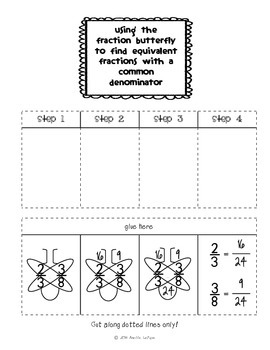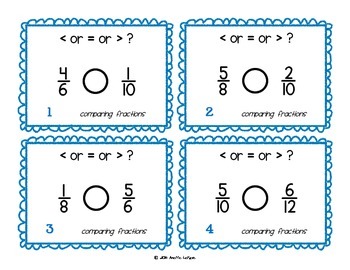Fraction Butterfly Interactive Notebook Pages and Task Cards
MrsLeFave
2.1k Followers
Resource Type
Standards
CCSS4.NF.A.2
CCSS5.NF.A.1
Formats Included
- PDF
Pages
31 pages
MrsLeFave
2.1k Followers
Description
Included in this product are interactive notebook pages and task cards for using the fraction butterfly (aka cross multiplying) to:
1. compare fractions with different denominators,
2. find a pair of equivalent fractions with a common denominator, and
3. add & subtract fractions with different denominators.
The fraction butterfly provides a visual way to remember the strategy for adding & subtracting fractions in the CCSS 5.NF.A.1 (a/b + c/d = (ad + bc)/bd), but also can be used to compare fractions and find a pair of equivalent fractions with a common denominator – part of the CCSS 4.NF.A.2.
Each of the three includes:
• 3 versions of an interactive notebook flippable with either all or some information completed.
• 1 set of twenty task cards (with recording and answer sheets) to practice the skill in the flippable. Fractions on the task cards are limited to those with denominators 2, 3, 4, 5, 6, 8, 10, and 12 to meet the grade 4 CCSS expectations.
I like to laminate the task cards so that students can use a dry erase marker to draw the butterfly on the task card.
Please check out the preview to ensure that the product will meet your expectations. Also check out my Fraction Butterfly Mini Anchor Chart freebie.
If you have any questions or comments, please contact me at MrsLeFave@gmail.com. Please visit my TpT store for additional products, or follow me on Pinterest.
Thank you!
Mrs. LeFave
1. compare fractions with different denominators,
2. find a pair of equivalent fractions with a common denominator, and
3. add & subtract fractions with different denominators.
The fraction butterfly provides a visual way to remember the strategy for adding & subtracting fractions in the CCSS 5.NF.A.1 (a/b + c/d = (ad + bc)/bd), but also can be used to compare fractions and find a pair of equivalent fractions with a common denominator – part of the CCSS 4.NF.A.2.
Each of the three includes:
• 3 versions of an interactive notebook flippable with either all or some information completed.
• 1 set of twenty task cards (with recording and answer sheets) to practice the skill in the flippable. Fractions on the task cards are limited to those with denominators 2, 3, 4, 5, 6, 8, 10, and 12 to meet the grade 4 CCSS expectations.
I like to laminate the task cards so that students can use a dry erase marker to draw the butterfly on the task card.
Please check out the preview to ensure that the product will meet your expectations. Also check out my Fraction Butterfly Mini Anchor Chart freebie.
If you have any questions or comments, please contact me at MrsLeFave@gmail.com. Please visit my TpT store for additional products, or follow me on Pinterest.
Thank you!
Mrs. LeFave
Total Pages
31 pages
Answer Key
Included
Teaching Duration
N/A
Report this resource to TPT
Reported resources will be reviewed by our team. Report this resource to let us know if this resource violates TPT’s content guidelines.
Standards
to see state-specific standards (only available in the US).
CCSS4.NF.A.2
Compare two fractions with different numerators and different denominators, e.g., by creating common denominators or numerators, or by comparing to a benchmark fraction such as 1/2. Recognize that comparisons are valid only when the two fractions refer to the same whole. Record the results of comparisons with symbols >, =, or <, and justify the conclusions, e.g., by using a visual fraction model.
CCSS5.NF.A.1
Add and subtract fractions with unlike denominators (including mixed numbers) by replacing given fractions with equivalent fractions in such a way as to produce an equivalent sum or difference of fractions with like denominators. For example, 2/3 + 5/4 = 8/12 + 15/12 = 23/12. (In general, 𝘢/𝘣 + 𝘤/𝘥 = (𝘢𝘥 + 𝘣𝘤)/𝘣𝘥.)





